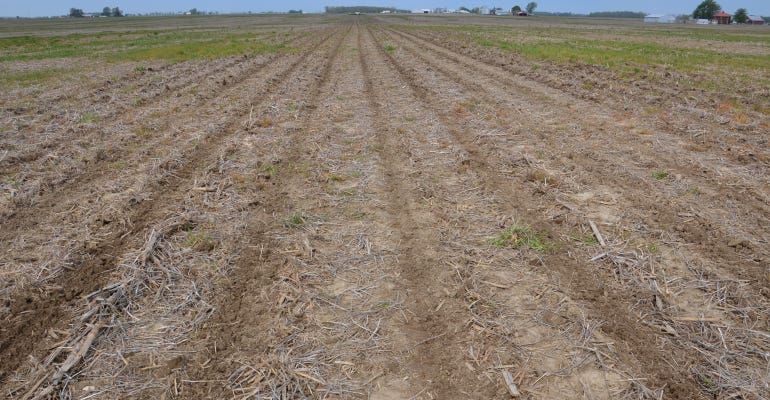
You go to private applicator recertification program meetings and hear talks about weed control. How do you turn that information into real-life weed control?
Bill Johnson, Purdue University Extension weed control specialist, has agreed to examine real field situations based on pictures and offer recommendations. Hopefully these examples will spark ideas for your own weed control strategies.
No-till with thin cover crop
This field was just planted to corn. It has a thin, spotty stand of a ryegrass cover crop due to poor germination conditions. You still must account for the annual ryegrass that is present, Johnson cautions.
You could use labeled rates of glyphosate if it’s not glyphosate-resistant annual ryegrass, Johnson says. Glyphosate-resistant annual ryegrass hasn’t been a big problem in Indiana, though it’s been documented in Kentucky, and there could be some in southern Indiana. You could opt for a paraquat or Liberty-based program.
If your choice is paraquat, apply before corn emerges. If you choose Liberty and plan to spray after corn emerges, make sure it’s LibertyLink corn.

HANDLE COVER CROP: Even though the cover crop is thin in this field, weed control experts say you still must account for it in your weed control plans.

For residual weed control, an atrazine premix before emergence would be an economical choice, Johnson says. He recommends a residual corn herbicide and cautions about applying it with nitrogen solutions after corn emerges. Check labels carefully. Also, be cautious if you choose to apply 2,4-D or dicamba on spike-stage corn. There is more likelihood for injury. Balance Flexx is an option for residual control on corn up to the V2, or two-leaf, stage.
If you were planting soybeans behind soybeans, still account for the sparse annual ryegrass with paraquat, glyphosate or Liberty, Johnson says. For residual control of waterhemp and marestail, you have several options, including Valor, Authority, Sharpen, Zidua and Sencor. If it’s a lighter soil with less than 2% organic matter, there may be plant-back restriction intervals for some products, which would take them out of use after planting. Consult labels.
Conventional tillage
The field featured in the photo at the top of the story is in conventional tillage and planted to corn. Here are Johnson’s thoughts for that field:
“If you expect heavy weed pressure and want a ‘Cadillac’ treatment, consider a three- or four-way premix for a preemergence application,” he says. “The premix should include atrazine, a Group 15 herbicide, plus a third component, which might be Balance, Callisto or Hornet.”
You could also go with Accuron or Corvis plus more atrazine, he says. Another choice would be Resicore plus extra atrazine.
Ideally, you’ll receive an inch of rain the first week and another inch the second week after application. If it doesn’t rain, herbicides could miss the first flush or weeds, requiring a postemergence spray.
Without irrigation, the only other option is rotary hoeing to incorporate herbicide, Johnson says.
Editor’s note: This is the second story in a series of articles about “real-field” recommendations. Recommendations are not all-inclusive. Read the first story, and see the 2019 Ohio, Indiana and Illinois Weed Control Guide for more options.
About the Author(s)
You May Also Like




